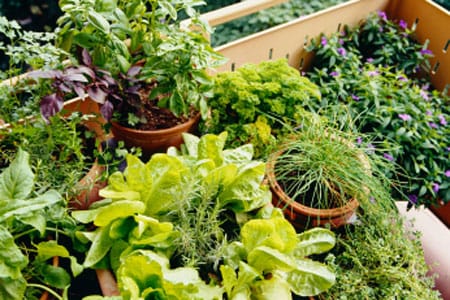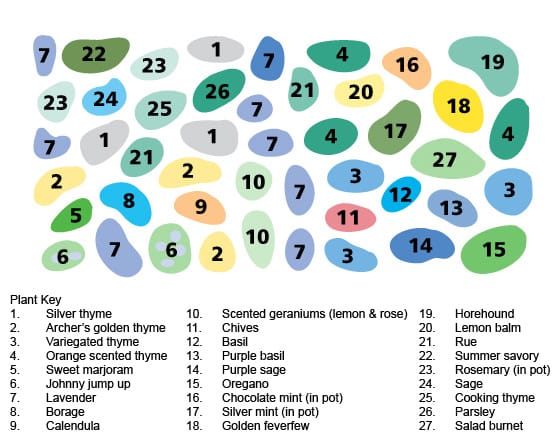Give your herbs a good home in the sun and they'll thrive all summer long.
For many years, the only herbs most of us ever saw were those little jars of grey-brown pulverized flakes of oregano, basil, savoury and sage that sit on grocery store shelves for far longer than anyone knows. Recently, however, there's been a herbal renaissance of sorts, and produce departments often carry at least half a dozen types of fresh herbs. But the freshest and best flavours are found when you step out your back door and pick a handful of basil or thyme or chervil. Your own plants ensure a steady, fresh supply, and when you want to preserve some for future use, you can pick them when they're at their prime.
A herb planting can be as easy as a pot of rosemary or thyme on your deck; as complex as the precisely laid out knot gardens at Annapolis Royal Historic Gardens (see page 30). You can combine herbs in a bed with other edibles in what might be called a potager, or intersperse them with ornamental plants in decorative borders. Themes aside, a simple raised bed provides a great environment for a herb planting. Raised beds provide good drainage-which herbs love-soil that warms earlier in the spring and, with the right dimensions, easy access for pruning and weeding without having to walk on the soil, which makes it compacted. And it's convenient to have all your culinary plants in one place.
The materials used to edge a raised bed range from cinder blocks to landscaping ties, paving stones to ornate filigree. I've seen them built with lovely old barn boards, but tearing boards off my existing barn doesn't seem to go over well with my spouse. Being a thrifty Maritimer who is more interested in spending money on plants than on building beds, I opt for the inexpensive and easy-to-acquire type of supplies, in this case a few wood planks and screws. Wood is versatile and blends in with most gardening styles and, by building a basic frame, it'll be easy to disassemble and move it if you decide you want to.
Left untreated, some wood types hold up better than others over time. Eastern cedar handles the elements reasonably well, but it can also be pricey. Karen Verboom of Nova Tree Company Inc., in Truro, says larch is a long-lasting and less expensive wood for lawn and garden use, as is hemlock. "Black spruce is also very durable and readily available," she says, which is what I tend to use admittedly because we have acres of it but also because it's tough. If you're planning to treat your lumber, be sure you use an organic product, such as Lifetime Wood Treatment or Bioshield-many of the common wood preservatives on the market can leach toxins into the immediate area, and shouldn't be used around food plants.
The first step is to locate a good site on your property-herbs that are not happy will not flourish. Many herbs, such as lavender, sage, rosemary, thyme and yarrows, love sun, so look for a site with at least five to six hours of full sun a day. Building your bed near a sheltering structure such as a wall can increase the ambient warmth for the plants and protect them from extremities of wind, which adversely affects them. And the closer you can locate your herb bed to your kitchen, the more apt you are to dash outside to snip a few sprigs at suppertime.
While you may have to remove a bit of sod and soil in order to level the site, there's no need for hours of digging-you're building a bed on top of what's there. However, it's good idea to prepare the bed by mulching with newspaper, which smothers underlying weeds and grass. (I know of one gardener who uses old synthetic feed bags under her frames, and extends the bags out for several inches around the perimeter of the frame to prevent weeds from sneaking into the bed.) Although you can dig up soil from your garden to fill in your raised bed, unless you have great loam with excellent drainage, you're further ahead to purchase a few bags of composted manure, peat moss and potting soil, and mix them together. This ensures that your new bed has good drainage and some organic matter, but also that it starts out as a weed-free site. Many gardeners have their own preferred recipes for soil mixes, but the main thing to remember is that herbs prefer good drainage. Also, amending the soil with compost will be sufficient to feed your herbs without requiring supplemental fertilizer. Ironically, over fertilizing herbs will produce plenty of growth but not good flavour or fragrance in your plants. If you buy a soil mix, choose one from the Atlantic area-a California potting mix would have a different composition than one for a cool, wet climate.
Selecting the herbs to fill in your bed is fun, although the choices can seem overwhelming. Which of the many marvellous basils to use? Do you want a compact lavender that will flower its first year or a taller, more fragrant variety? Are you going to stick with culinary herbs, or do you want a smattering of medicinal or aromatherapy plants-or others for mere visual interest to your bed? Here's where browsing through catalogues and talking to knowledgeable nursery growers can help you make the choices that will most please you.
Deciding on the design of your bed can also seem puzzling, but here's where you think about your style. Do you like the formality of precisely laid out rows, blocks or even geometric knots, or prefer a free form or cottage-style profusion of plants? Some gardeners will divide their beds into sections for medicinals, culinary, flowering and ornamental plants; others will plant with a curving pattern in mind, perhaps creating a border with ornamental thyme or lavender to section off various herbs.
I've also seen a lovely display where the herbs were planted in large terra-cotta or resin pots, then sunk into a raised bed that was mulched in pea gravel. The pea gravel holds and reflects heat, helping warmth-loving herbs to thrive; keeping weeds to a minimum is easy. These pots can be lifted out and moved easily indoors during the winter months. But they'd need to be watered frequently-probably every day. With all that warmth they'd dry out even quicker than most pots do.
Whatever you do, bear in mind what types are hardy perennials and what are annuals or tender perennials, which either have to be brought inside at season's end or replanted yearly.

Supplies
- Herb plants (see end of article for suggestions)
- 6"- 8" pots (for invasive herbs such as mint, or tender prennials such as rosemary and scented geraniums that you want to bring inside over winter)
- Timber: 2 planks 8'L x 10"H x 2"W ; 2 planks 4'Lx 10"H x 2" W
- Level
- 4 stakes and twine
- Drill with appropriate bit for deck screws
- 8 inside corner braces
- 1 pound 2 1/2" treated deck screws (you can never have too many…)
- Organic wood preservative (optional)
- Soil
- Wheelbarrow and hoe for mixing soil
- Hose and water
- Weather resistant labels and permanent marker
- Mulching material
Directions

Frame 1

Frame 2

Garden Plan
- Choose a level site to accommodate the 8' x 4' bed, and don't worry about grass or weeds already in the area. By putting down layers of newspaper at the bottom of the bed before you add the soil, you'll effectively smother out what's there.
- Purchase your herbs. All gardens have an aesthetic value beyond practical use, and many spectacular plantings combine both ornamental or landscaping herbs with those used for culinary, potpourri or medicinal uses. There's no harm in mixing ornamental thyme with edibles, for example-just make sure you label any plants that are new to you, particularly if they're not meant to be eaten.
- Buy your lumber-if you're leaving it untreated, consider larch, black spruce or hemlock. Lay out the perimeter of your bed using stakes and twine or rope, allowing a few extra inches on all sides for the width of the wood.
- Over the entire area marked out, put down layers of at least a dozen pages of newspaper. If there's a breeze, dampen the papers with the hose so you don't spend the day chasing errant sheets. Newspaper will decay over time, adding more organic matter to the soil.
- Assemble the plank frame (see diag-ram). If wide planks are unavailable, two 2 x 6s can be used, although you'll need to put a supporting piece midway down each side to help hold the boards flush. Bracing the corners with corner brackets on the inside of the frame will help to give it strength.
- Once the frame is assembled, place it over the dampened newspapers, and use a level to make sure it is sitting straight.
- Add soil, but don't tamp it down. Shovel it in to a bit higher than level with the top of the frame, then water well so that the soil is uniformly moist but not sodden. This helps to prevent transplant shock to your new plants.
- If you've sketched out a design for your bed but still aren't sure how it will work, try positioning the still-potted herbs on top of the soil until you're satisfied with how you want to plant them.
- As with transplanting of any type, choose a mild and overcast day to plant your herbs, and water them well to reduce transplant shock. If you've been growing them indoors, make sure you've hardened them off by putting them outside a few hours for several days prior to planting them outside. Plant herbs with the recommended spacing-as plants grow and fill in, they'll shelter the soil and suppress weeds, and also shade their roots, helping to keep them cool and the soil from drying out. Tamp down around plants to eliminate air pockets, water again and apply a 2-inch layer of mulch. With the dry summers we've had in recent years, water-wise gardening is always a good practice.
- Label your plants. Until you get used to their foliage and scents, many herbs can look quite similar. Purchased herbs often come with labels, frequently with illustrations of the plant, but if your plants don't have these you can make up labels using permanent markers to write on them.
- Like any plants, herbs are susceptible to pests and diseases, although some of the more fragrant ones seem to have repellent properties. Slugs are often a problem, especially with the more tender plants such as basil, but keeping the grass around your raised bed well trimmed and hand-picking slugs you see will go a long way in keeping these pests at bay.
A sneak peek at Jodi's picks…
The planting plan here, based on my herb bed, is a lively mixture of mostly standard culinary varieties, with a few interesting variations thrown in for texture, fragrance and colour. Fragrance in foliage is as appealing to me as it is in flowers, so lemon balm, scented geraniums and thymes, and the safely potted mints are more for their scents than for cooking purposes.
The deep burgundy foliage of purple basil appeals to me as much as the flavour of regular basil. The same goes for the sages with their different colours, the golden feverfew with the shimmery gold-green foliage, and the numerous ornamental thymes used as accent plants. I love the sunny colours of calendula and the cheery faces of Johnny-Jump-Ups, the shimmery blue of borage, and who doesn't love lavender?
I also mix herbs such as calendula, lavender, echinacea and borage into the main gardens around our property, because they are some of my favourite plants and it's a case of "the more, the merrier"-especially with lavender!
Herb hotlists
Many common herbs are well known and easily recognized. For unusual herbs, it's a good idea to note botanical names, so you know what you're looking for (common names are less reliable). Check cultivation labels to make sure of plants' growth habits, their requirements and whether they're winter hardy.
Culinary herbs
Rosemary, basil, thyme, oregano, sage, parsley, sweet marjoram, lemon balm (Melissa officinalis) summer and winter savouries, chives, coriander/cilantro, mints, French tarragon (Artemisia dracunculus) (Note: Avoid Russian tarragon, A. dracunculus dracunculoides, which is commonly sold but is essentially devoid of any flavour.) Try variegated or purple sage for an interesting change in foliage colour.
Edible-flowered plants
In the course of researching this story, I learned that the flowers of the only plant I hate, goutweed (Aegopodium podegraria, an invasive worse than any mint), is edible, both flowers and leaves. I'm going to eat the entire plot that I'm cursed with! Other edible flowers include mints, dianthus, evening primrose, sweet woodruff, and scarlet beebalm. Pot marigolds (calendula), pansies/violas, borage (Borago officinalis), nasturtiums, lavender, chives, cilantro, roses, scented geraniums.
Medicinal herbs
Many grow these more for their flowers and foliage than for medicinal use, but if you're interested in herbal medicine, there are plenty of excellent references to be found in libraries and online: Valerian (Valeriana officinalis), Echinacea (Echinacea purpurea), Chamomile (Chamaemelum nobile), Foxgloves (Digitalis purpurea), Comfrey (for external use), Feverfew (Tanacetum parthenium), St. John's wort (Hypericum perforatum), Pearly everlasting (Anaphalis margaritacea), Yarrow (Achillea), Eucalyptus (Eucalyptus globulus)
Unusual herbs
Whether you grow these for novelty, for their ornamental value or for culinary use, they go beyond the basic, traditionally grown herbs. Curry plant (Helichrysum italicum), stevia (Stevia rebaudiana), Horehound (Marrubium vulgare), hyssop (Hyssopus officinalis), angelica (Angelica archangelica) lovage (Levisticum officinale), hops (Humulus lupulus), salad burnet (Poterium sanguisorba), bergamot (Monarda fistulosa), catnip (Nepeta cataria), rue (Ruta graveolens), horseradish (Armoracia rusticana)
